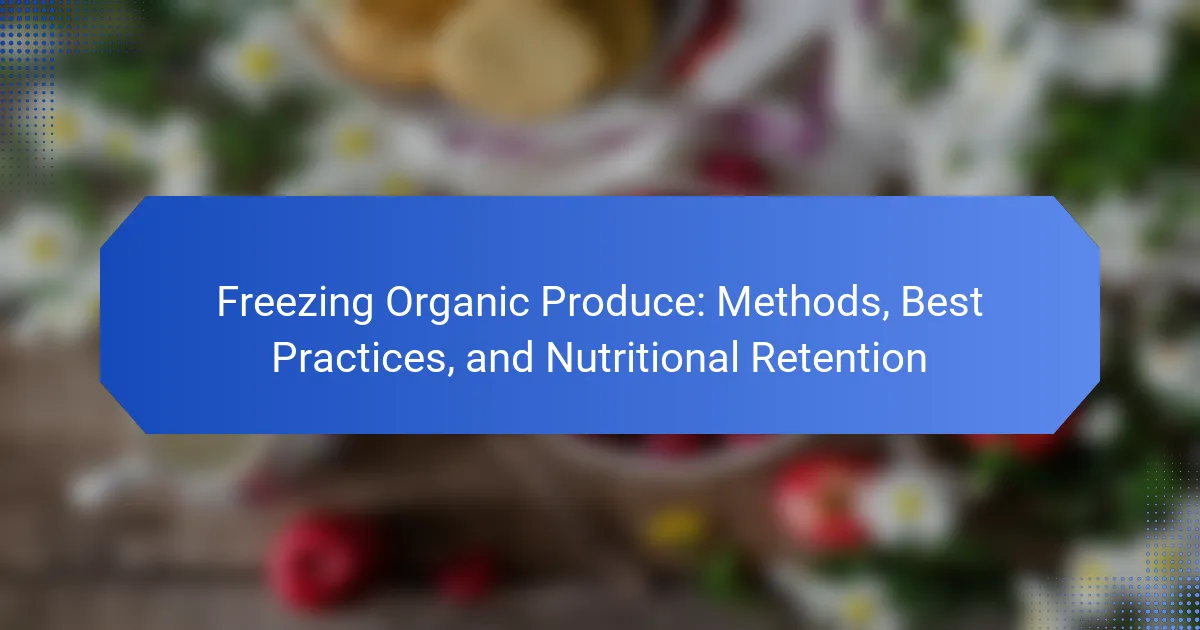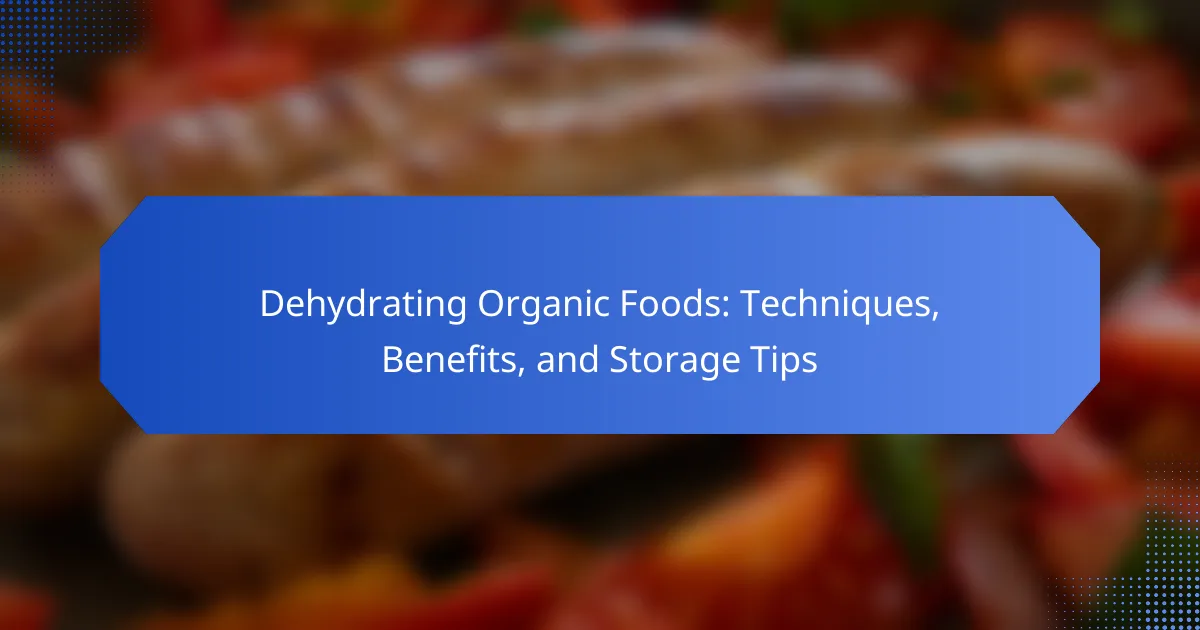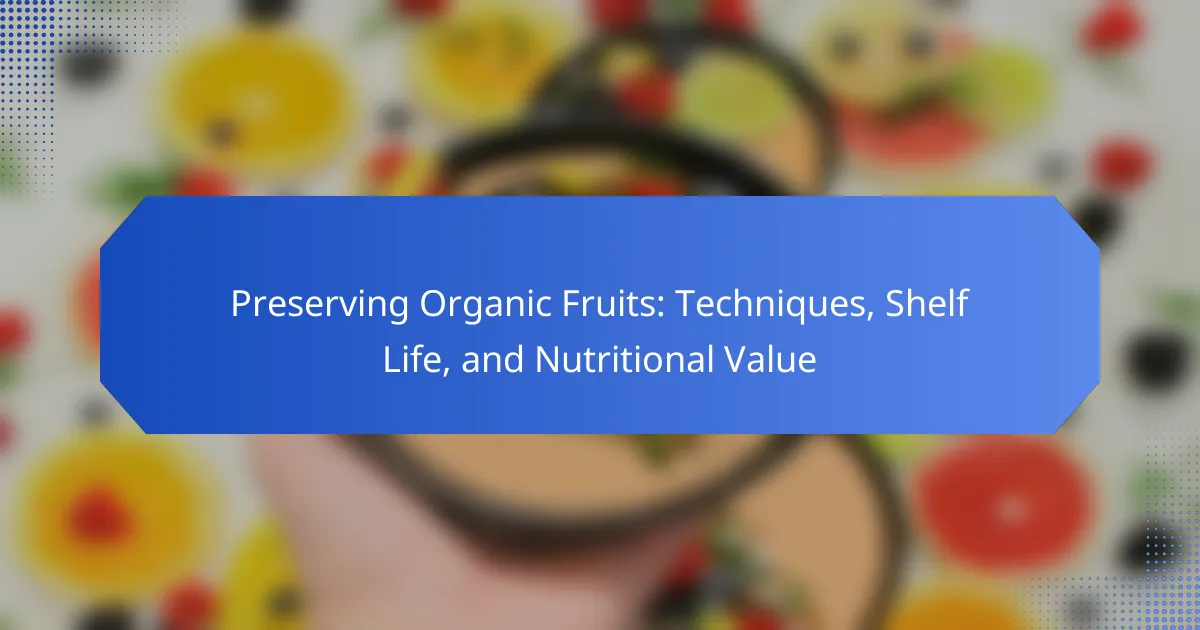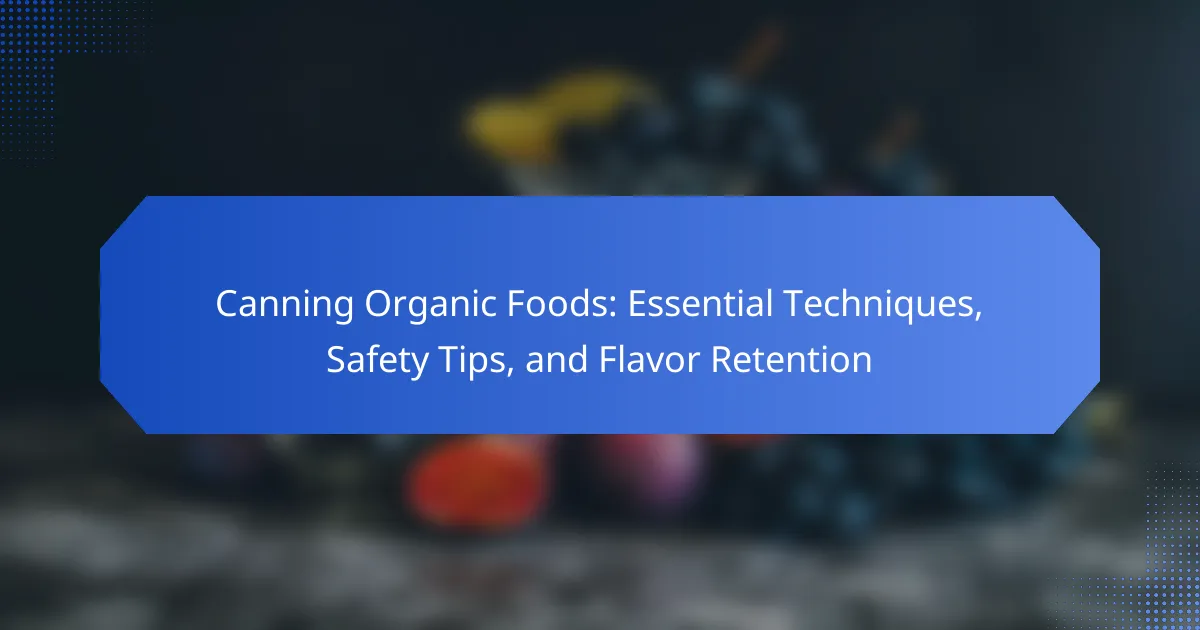Temperature is a critical factor in the preservation of organic food, directly influencing the growth of spoilage-causing microorganisms and enzymatic reactions. Maintaining lower temperatures, particularly below 4°C, significantly reduces spoilage rates and extends the shelf life of organic produce. Key factors affecting temperature management include ambient temperature, storage conditions, and microbial activity, all of which play a role in food integrity. Effective preservation strategies, such as refrigeration, freezing, vacuum sealing, and using airtight containers, are essential for ensuring that organic foods remain safe and nutritious over time. This article outlines the best practices for temperature control in organic food preservation and highlights the importance of proper management techniques.
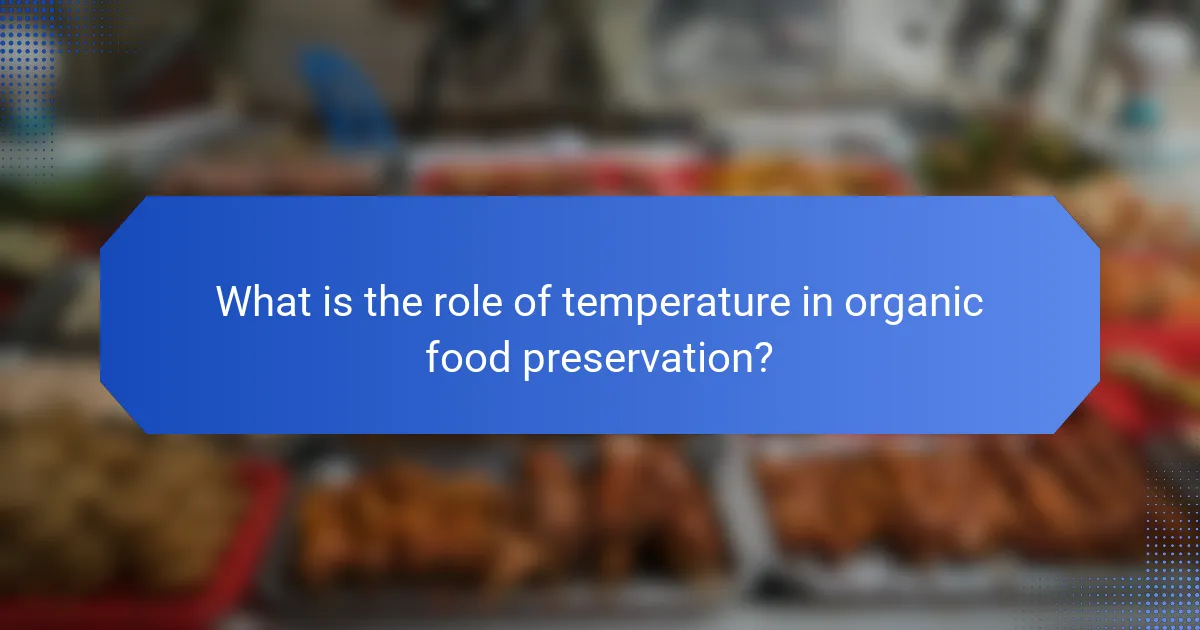
What is the role of temperature in organic food preservation?
Temperature plays a crucial role in organic food preservation. It affects the growth of microorganisms that cause spoilage. Lower temperatures slow down enzymatic reactions in food. This helps maintain the quality and safety of organic produce. For instance, refrigeration can extend the shelf life of fruits and vegetables significantly. Studies show that storing organic food at temperatures below 4°C reduces spoilage rates. Conversely, high temperatures can accelerate decay and nutrient loss. Proper temperature management is essential for maintaining the integrity of organic foods.
How does temperature affect the shelf life of organic foods?
Temperature significantly affects the shelf life of organic foods. Higher temperatures accelerate the growth of microorganisms. This leads to faster spoilage and reduced shelf life. Conversely, lower temperatures slow down these processes. Refrigeration can extend the freshness of organic produce. For example, storing fruits and vegetables at 32°F to 40°F can prolong their viability. Research indicates that temperature fluctuations can also impact nutrient retention. Maintaining consistent temperatures is crucial for preserving quality and safety. Overall, optimal temperature regulation is essential for maximizing the shelf life of organic foods.
What is the ideal temperature range for preserving organic foods?
The ideal temperature range for preserving organic foods is between 32°F and 40°F (0°C to 4°C). This temperature range slows down the growth of bacteria and mold. It also helps maintain the freshness and nutritional value of organic produce. Studies show that storing organic foods within this range can extend their shelf life significantly. For example, refrigeration at these temperatures can reduce spoilage and waste. Proper temperature control is essential for effective organic food preservation.
How do different temperatures impact the quality of organic produce?
Different temperatures significantly impact the quality of organic produce. Higher temperatures can accelerate the degradation of nutrients and lead to spoilage. For instance, organic fruits and vegetables stored above 50°F can lose flavor and texture quality. Conversely, lower temperatures can extend shelf life and preserve freshness. However, temperatures below freezing can damage cell structure in some organic produce. Studies show that maintaining a temperature range of 32°F to 41°F optimally preserves the quality of most organic fruits and vegetables. Proper temperature management is crucial for minimizing loss of vitamins and maintaining overall produce quality.
Why is temperature control critical in organic food preservation?
Temperature control is critical in organic food preservation because it helps maintain the quality and safety of the food. Proper temperature regulation slows down the growth of bacteria, molds, and yeast. These microorganisms can spoil food and pose health risks. For instance, organic produce is particularly susceptible to spoilage due to its lack of preservatives. Research shows that storing organic fruits and vegetables at temperatures below 40°F can extend their shelf life significantly. A study published in the Journal of Food Science found that temperature fluctuations can lead to increased respiration rates in organic produce, causing faster degradation. Maintaining a consistent temperature also helps preserve the nutritional value of organic foods. Overall, effective temperature control is essential for ensuring the longevity and safety of organic food products.
What are the consequences of improper temperature management?
Improper temperature management can lead to food spoilage and safety hazards. When organic food is not stored at the correct temperature, microbial growth can accelerate. This increases the risk of foodborne illnesses. Additionally, improper temperature can cause nutrient loss in organic produce. For instance, fruits and vegetables may lose vitamins and minerals when exposed to excessive heat. Furthermore, improper cooling can lead to texture and flavor degradation. These consequences highlight the importance of maintaining optimal temperature conditions for food preservation.
How does temperature influence microbial growth in organic foods?
Temperature significantly influences microbial growth in organic foods. Microorganisms, including bacteria and fungi, thrive within specific temperature ranges. Optimal temperatures for growth typically range from 20°C to 45°C (68°F to 113°F). Within this range, microbial metabolism accelerates, leading to faster reproduction. Conversely, temperatures below 0°C (32°F) can inhibit growth by slowing down metabolic processes. High temperatures, above 60°C (140°F), often kill most pathogens and spoilage organisms. For instance, pasteurization uses heat to eliminate harmful microbes in organic products. Studies show that maintaining refrigeration at 4°C (39°F) can significantly extend the shelf life of organic foods by reducing microbial activity.
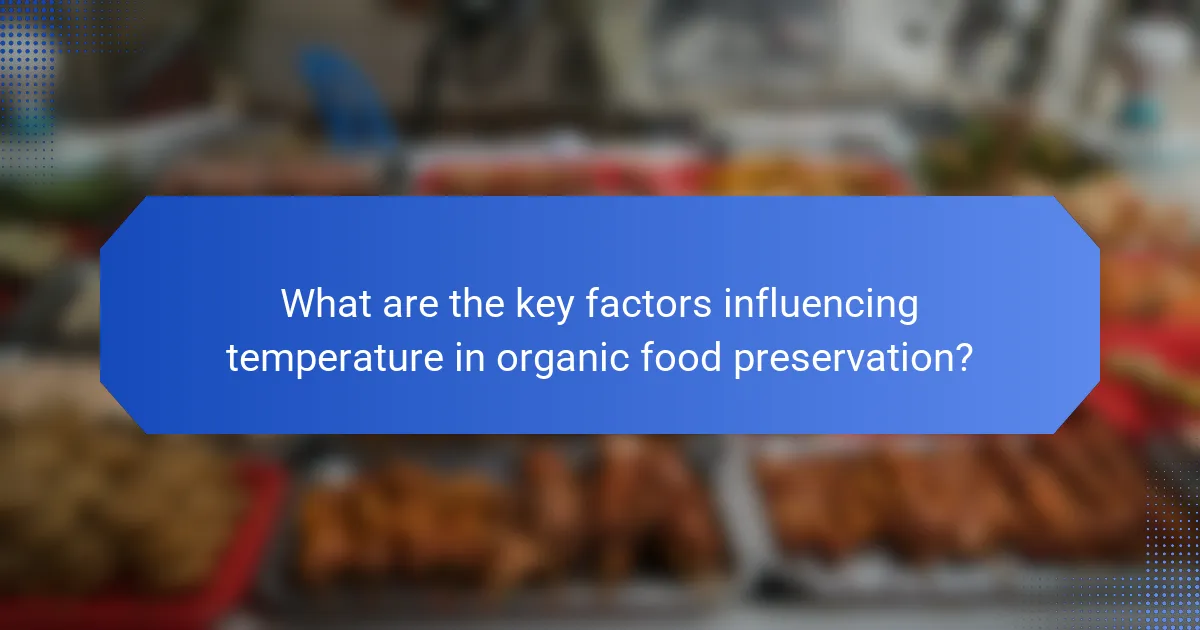
What are the key factors influencing temperature in organic food preservation?
The key factors influencing temperature in organic food preservation include ambient temperature, storage conditions, and microbial activity. Ambient temperature affects the rate of spoilage. Higher temperatures accelerate chemical reactions that lead to degradation. Storage conditions such as humidity and light exposure also impact temperature control. Microbial activity increases at warmer temperatures, leading to faster food spoilage. Proper temperature management can extend the shelf life of organic foods. Research shows that maintaining temperatures below 5°C can significantly reduce spoilage rates in perishable organic products.
How do environmental conditions affect temperature control?
Environmental conditions significantly influence temperature control. Factors such as humidity, air circulation, and external temperature can affect how effectively temperature is maintained. High humidity can lead to increased moisture levels, impacting temperature regulation in storage environments. Conversely, low humidity can cause rapid temperature fluctuations. Air circulation is crucial; stagnant air can create hot spots, while proper ventilation helps maintain consistent temperatures. External temperatures also play a role; warmer outside conditions can challenge cooling systems. Studies indicate that maintaining optimal environmental conditions can enhance energy efficiency in temperature control systems.
What role does humidity play in temperature management?
Humidity significantly influences temperature management in environments where organic food is preserved. High humidity levels can slow down the rate of heat transfer, affecting the overall temperature regulation. Conversely, low humidity can lead to increased evaporation, which can lower temperatures but may also cause dehydration of food products. Research indicates that maintaining optimal humidity levels, typically between 30% to 50%, is crucial for effective temperature management in food preservation. Proper humidity control helps prevent spoilage and maintains food quality by balancing moisture loss and temperature fluctuations.
How does the type of organic food impact temperature requirements?
The type of organic food significantly impacts temperature requirements for preservation. Different organic foods have varying sensitivities to temperature changes. For instance, leafy greens require cooler temperatures to maintain freshness, typically between 32°F and 35°F. Conversely, root vegetables can be stored at slightly higher temperatures, around 32°F to 40°F. Fruits often need specific temperature ranges; for example, berries are best preserved at temperatures below 32°F.
These temperature specifications are crucial to prevent spoilage and maintain quality. According to the USDA, improper temperature can lead to accelerated decay and nutrient loss. Therefore, understanding the specific temperature needs for each type of organic food is essential for effective preservation.
What are the best practices for maintaining optimal temperatures?
The best practices for maintaining optimal temperatures include using proper refrigeration techniques and monitoring temperature consistently. Refrigerators should be set to 34-40°F (1-4°C) to preserve food quality. Regularly check the temperature with a calibrated thermometer. Avoid opening the refrigerator frequently, as this can raise the internal temperature. Ensure that food is stored in airtight containers to prevent temperature fluctuations. Organize food items to allow for proper air circulation. Keep the refrigerator clean and defrost it regularly to maintain efficiency. These practices help to inhibit bacterial growth and extend the shelf life of organic food.
How can technology assist in temperature monitoring and control?
Technology assists in temperature monitoring and control through advanced sensors and automated systems. These sensors provide real-time data on temperature fluctuations. Automated systems can adjust cooling or heating mechanisms based on sensor readings. Data loggers can record temperature over time for analysis. Mobile applications allow remote monitoring and alerts for temperature changes. IoT devices enable integration with other systems for comprehensive control. Research shows that precise temperature control can extend the shelf life of organic foods. Effective monitoring reduces spoilage and maintains quality, ensuring food safety.
What are common methods for cooling and storing organic foods?
Common methods for cooling and storing organic foods include refrigeration, freezing, and using cool storage facilities. Refrigeration slows down the growth of bacteria and preserves freshness. Most organic foods can be stored in a refrigerator at temperatures between 32°F and 40°F. Freezing is another effective method, halting bacterial growth and extending shelf life. Foods can be stored in a freezer at 0°F or lower for long-term preservation. Cool storage facilities, such as root cellars, maintain stable, low temperatures and humidity levels. These methods help maintain the quality and safety of organic foods.

What specific strategies can enhance organic food preservation?
Refrigeration is a primary strategy to enhance organic food preservation. This method slows down microbial growth and enzymatic reactions. Maintaining a temperature below 40°F (4°C) is crucial. Freezing organic foods can extend their shelf life significantly. The process halts microbial activity and preserves nutritional content. Vacuum sealing prevents oxidation and moisture loss. This method can double the storage time of organic produce. Utilizing airtight containers also helps maintain freshness. These strategies collectively ensure that organic foods remain safe and nutritious for longer periods.
How can consumers effectively preserve organic foods at home?
Consumers can effectively preserve organic foods at home by utilizing methods such as refrigeration, freezing, canning, and dehydration. Refrigeration slows down the growth of bacteria and molds, extending the freshness of perishable items. Freezing organic foods preserves their nutrients and flavor by halting enzymatic activity. Canning involves sealing foods in airtight containers, which prevents spoilage by eliminating oxygen. Dehydration removes moisture from foods, inhibiting the growth of microorganisms. According to the USDA, proper temperature control is crucial in all these methods to maintain food safety and quality.
What tools and equipment are recommended for home preservation?
Recommended tools and equipment for home preservation include canning jars, lids, and a canner. Canning jars are essential for storing preserved foods. Lids ensure a proper seal for the jars. A canner, whether a water bath or pressure canner, is necessary for safely processing jars. Additionally, a food dehydrator is useful for drying fruits and vegetables. A vacuum sealer helps in preserving food by removing air from bags. Lastly, a thermometer is crucial for monitoring temperatures during preservation processes. These tools are widely recognized for their effectiveness in maintaining food quality and safety during preservation.
What tips can help maintain the freshness of organic produce?
Store organic produce in a cool, dry place. Refrigeration slows down the ripening process. Use breathable bags to allow air circulation. Avoid washing produce before storage to prevent moisture buildup. Keep fruits and vegetables separate to reduce ethylene exposure. Use a crisper drawer for optimal humidity control. Consume organic produce within a week for best quality. These practices help maintain freshness and extend shelf life.
What are the common challenges in temperature management for organic foods?
Common challenges in temperature management for organic foods include maintaining consistent temperatures, preventing temperature fluctuations, and ensuring proper refrigeration. Organic foods are sensitive to temperature changes, which can lead to spoilage. Inconsistent temperatures can affect the quality and safety of organic produce. Temperature fluctuations during transportation can compromise freshness. Additionally, inadequate refrigeration can lead to microbial growth. These factors necessitate careful monitoring and management to preserve organic food quality.
How can fluctuations in temperature be minimized during storage?
Fluctuations in temperature during storage can be minimized by maintaining a consistent environment. Utilizing insulated storage containers helps reduce temperature variations. Employing temperature monitoring systems allows for real-time tracking. Regular maintenance of cooling systems ensures optimal performance. Storing products away from heat sources prevents unintended warming. Implementing proper airflow within storage areas aids in even temperature distribution. Research indicates that stable temperatures can extend the shelf life of organic foods significantly. For instance, a study published in the Journal of Food Science found that maintaining a consistent temperature can reduce spoilage by up to 30%.
What troubleshooting steps can be taken for temperature-related issues?
Identify the source of the temperature issue. Check appliances like refrigerators or freezers for proper function. Ensure that the thermostat settings are accurate and not malfunctioning. Inspect door seals for any gaps that may cause temperature fluctuations. Monitor the internal temperature with a reliable thermometer for accuracy. Remove any obstructions that may block airflow within the appliance. Regularly defrost freezers if ice buildup occurs, as this can affect temperature regulation. Lastly, consult the user manual for specific troubleshooting guidance related to the appliance in question.
What are the best practices for ensuring effective organic food preservation?
The best practices for ensuring effective organic food preservation include maintaining optimal storage temperatures, using airtight containers, and employing natural preservatives. Proper temperature control slows down spoilage and microbial growth. For most organic foods, refrigeration at temperatures below 40°F (4°C) is recommended. Airtight containers prevent exposure to air, reducing oxidation and moisture loss. Natural preservatives like vinegar, salt, and sugar can inhibit spoilage. Additionally, regular monitoring for signs of spoilage is essential. Implementing these practices can significantly extend the shelf life of organic foods while maintaining their nutritional value.
The main entity of this article is temperature, specifically its role in organic food preservation. The article outlines how temperature affects the growth of microorganisms, shelf life, and quality of organic foods, emphasizing the importance of maintaining optimal temperature ranges, typically between 32°F and 40°F (0°C to 4°C). It discusses best practices for temperature management, including refrigeration techniques, monitoring systems, and the impact of environmental conditions such as humidity. Additionally, the article highlights common challenges in temperature control and offers strategies for consumers to effectively preserve organic foods at home.
